Moving day
The College of Engineering's student services office was the first to move in to Marston Hall on July 20, following a two-year, $27.1 million renovation. The remaining tenants should be housed in the 113-year-old building by the end of July. A rededication event for Marston will be held on Sept. 29. Photos by Christopher Gannon.
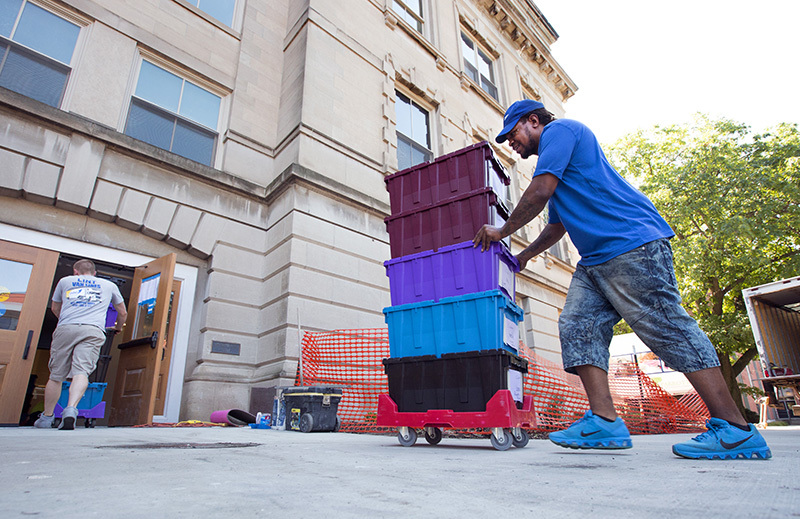
Shawn Green, right, of Lint Van Lines moves a cart of boxes into Marston Hall.
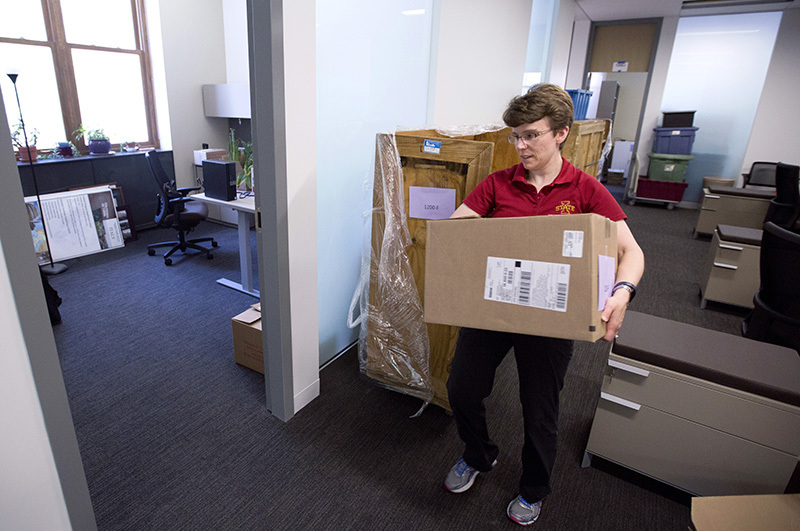
Shannon Miner, an adviser and coordinator for international engagement in Engineering student services, carries a box into her new office.
Related stories
- Project manager's blog: Uncovering a century of memories in Marston Hall, July 15, 2016
- Engineering College will reclaim Marston, June 9, 2016
- Marston project headed for June completion, March 3, 2016
- Marston Muses are getting a makeover, Aug. 6, 2015
- A peek inside Marston Hall, May 21, 2015
- Demo work in Marston turns up a few treasures, Jan. 22, 2015
- Interior demolition at Marston begins next month, Nov. 6, 2014
- Marston tenants are starting to move, June 5, 2014
Color your website accessible
Colors make websites vibrant and, sometimes, inaccessible. Those who are colorblind (about 1 in 12 men and 1 in 200 women) and those with low vision often cannot use certain websites due to their color schemes. It doesn't have to be that way.
Colorful websites that are accessible adhere to two key rules:
- Provide ample contrast between the foreground and background
- Don't use color alone to convey information
Accessibility assist
Got questions? Contact web accessibility coordinator Zayira Jordan, zjordan@iastate.edu, 294-0982.
Here are some practical examples of how to put these rules into practice.
Check the color contrast
The contrast ratio (or relative luminance) measures the contrast between foreground text and its background. Accessibility standards require contrast ratios to be at least:
- 4.5:1 for normal text (14-16 pt)
- 3:1 for larger text (14 pt bold or 18 pt)
There are a number of online and downloadable tools to check contrast ratios. Most also provide a "pass" or "fail" grade, based on standards of the Web Content Accessibility Guidelines (WCAG). Iowa State's proposed accessibility policy calls for university websites to comply with WCAG's Level AA standard.
- WebAim Color Contrast Checker
- Luminosity Colour Contrast Ratio Analyser
- WAVE. This accessibility tool checks all the colors on an existing page. Submit a URL, then click the "contrast" button (upper left side of the results page).
- Paciello Colour Contrast Analyser. This free tool can be downloaded to PCs or Macs.
Touch up forms
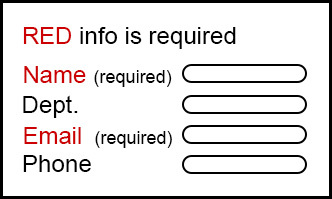
AFTER: "Required" text an easy fix
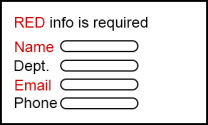
BEFORE: Some can't pick out the red
Color often is used in online forms to denote mandatory fields. The "before" form specifies that all red fields must be completed. Coloring the mandatory fields red is a helpful visual for some, but useless for those who can't easily differentiate between red and black text.
The "after" example keeps the red color cues, but backs them up by adding a "required" notation to mandatory fields. The added text opens the form to those who are color challenged and to those who use screen readers to view websites.
Color-safe charts
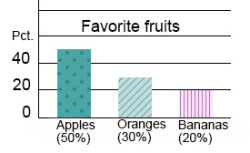
Color combos and patterns = accessible charts
To create accessible charts, use color combinations that are considered "colorblind safe." The Colorbrewer 2.0 site provides a number of color sets that are easy on the eyes of those who have limited color vision. To make bars and pie slices stand out even more, add different patterns to the charts.
It's also helpful to add text to help users interpret charts. For example, the text below the bars on the "Favorite Fruits" chart takes the hassle out of trying to figure out the percentages yourself.
Charts, like almost all visuals on a web page, also should be accompanied by descriptions of what the data means. These descriptions are essential for those using screen readers. For complex charts, the descriptive text may be posted on its own page with a link from the chart.
Related stories
- Accessible PowerPoints are on students' wishlist, March 30, 2017
- Captioning, with an assist from YouTube, Jan. 5, 2017
- Well formed forms, Oct. 20, 2016
- Links that do the job, Sept. 1, 2016
- Color your website accessible, July 21, 2016
- How to create accessible Word docs, June 23, 2016
- The art of alt text, June 9, 2016
Iowa State tops external funding record in FY16
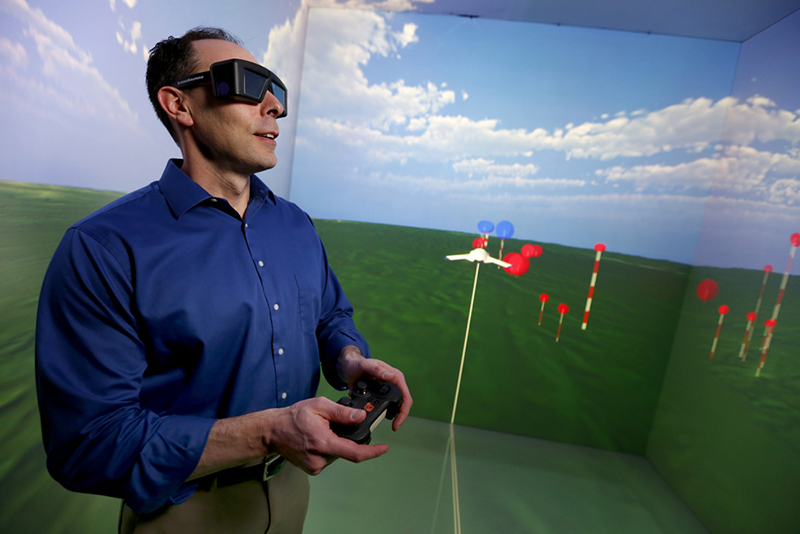
With the support of a new grant, mechanical engineering professor Eliot Winer will use his expertise in virtual and augmented reality to develop training tools for manufacturers. Photo by Christopher Gannon.
Iowa State attracted a record $425.8 million of external funding in the 2016 fiscal year that ended June 30.
That’s a slight increase over the previous record of $424.9 million raised in fiscal year 2015.
“This record support shows that Iowa State truly has the talent and facilities to be a leader in educating students and solving problems,” said President Steven Leath. “This outstanding support from government agencies, industry, foundations and individuals reinforces our tradition of cross-disciplinary work. And it positions us to do even more to impact our state, country and world.”
External funding includes grants, contracts, gifts and cooperative agreements from federal, state and local governments as well as from corporations, foundations and other universities.
The funds support Iowa State researchers, students, education programs, equipment purchases, building projects and extension activities. The funding is in addition to state appropriations, which support daily operations of the university.
A big part of Iowa State’s record year was unprecedented external support of Iowa State researchers. Research funding hit $252.5 million for fiscal year 2016. That’s a nearly 12 percent increase over the previous year’s research support of $225.7 million. The previous record for research funding was $239.2 million in fiscal year 2010.
“This jump in research funding is supporting exciting projects across the campus, including projects to develop new approaches in data-driven science, resilience of plants and animals in response to our changing climate, and educating students in next-generation plant science and electrical and computer engineering,” said vice president for research Sarah Nusser. “We’ve also seen research support from federal agencies, industry, nonprofits and the state grow to five-year highs. With all of this support, and the hard work and innovation of our researchers, we believe Iowa State can help future generations enjoy better lives.”
Here are a few examples of how this new funding is advancing Iowa State research and impacting society: With funding from the U.S. Department of Agriculture, Adina Howe, an assistant professor of agricultural and biosystems engineering, will study antimicrobial resistance in animal production systems. The National Network for Manufacturing Innovation -- Digital Manufacturing and Design Innovation Institute funded three new projects at Iowa State in advanced manufacturing. And Walter Suza, an adjunct assistant professor in agronomy, joins an international coalition funded by the Bill and Melinda Gates Foundation to improve global food security.
And here are some of Iowa State’s major sources of external funding during fiscal year 2016:
Federal agencies
- Energy, including the U.S. Department of Energy’s Ames Laboratory, $76,931,488
- National Science Foundation, $38,144,481
- Agriculture, $28,900,017
- Health and Human Services, including the National Institutes of Health, $12,931,909
- Defense, $8,358,265
- Transportation, $4,317,311
- Other federal, $5,157,866
Non-federal sources
- State of Iowa government, $22,207,158
- Industry/corporate, $20,399,183
- Higher education, $12,267,407
- Nonprofit organizations, $11,295,851
- Commodity groups, $6,482,671
- Other, non-federal, $5,095,349
External funding total (including many other sources)
$425,796,145
Regents approve tuition increases
Tuition for resident undergraduates will go up $250 this fall instead of $300, in a compromise approved July 18 by the state Board of Regents. Voting on an unusual second round of increases intended to make up for increased state operating support for fiscal year 2017 that was less than 30 percent of what the university requested, the board unanimously adjusted down the increase for resident undergraduates and approved other increases as proposed: $100 for nonresident undergraduates and all graduate students; and $50 for all veterinary medicine students.
The change reduces the estimated tuition revenue growth at Iowa State by $915,000, to approximately $32.6 million. By contrast, the increase in state operating dollars this year is $2.2 million.
Regent Larry McKibben proposed the smaller increase for in-state undergraduates.
"In the comments I received as a regent, there's a lot of concern out there about the increase, but also concern about how we maintain the high quality of the education at our three universities. So you're conflicted about what side you're going to pick," McKibben said.
"Some will say we're not coming down far enough, but I very much support it," he added.
Board president Bruce Rastetter noted that McKibben's proposal was vetted through the three university presidents to see if they could manage their budgets with less tuition revenue. All three told him yes, he said.
Rastetter also pledged changes to the board's tuition-setting process, including asking the Legislature to consider a two-year cycle for higher education appropriations and to conclude the state budget discussion earlier in the session because of its impact on university budgets -- and ultimately Iowa families if tuition rates are reset. Families receive fall tuition bills on Aug. 1, he noted, but plans for paying them begin much earlier.
Tuition adjustments
|
Student group |
Approved increase (December) |
Approved increase (July) |
Approved 2016-17 tuition |
|
Undergraduate |
|
|
|
|
Resident |
$0 |
$250 |
$7,098 |
|
Nonresident (U.S.) |
$594 |
$100 |
$20,462 |
|
International |
$1,094* |
$100 |
$20,962 |
|
Graduate |
|
|
|
|
Resident |
$244 |
$100 |
$8,474 |
|
Nonresident (U.S.) |
$632 |
$100 |
$21,786 |
|
International |
$1,132* |
$100 |
$22,286 |
|
Vet Med (years 1-3) |
|
|
|
|
Resident |
$826 |
$50 |
$21,530 |
|
Nonresident (U.S.) |
$1,386 |
$50 |
$47,636 |
|
International |
$1,386* |
$50 |
$47,636 |
*Includes $500 incremental tuition (first of three years) for all international students
Leath turns down summer salary increase
Rastetter announced that President Steven Leath and Iowa President Bruce Herreld both asked to forgo a compensation increase on July 1, the start of the new fiscal year. The board completed performance evaluations for the two at its June meeting, but Rastetter said, even prior to June, the two presidents indicated they would decline an increase. Leath and Herreld will receive scheduled mid-year evaluations in January 2017; Rastetter said compensation increases would be addressed again then.
Cost of instruction
Every other year since 1969, the state's three public universities have compiled a unit cost of instruction for the state Board of Regents. The most recent data, received by board members this month, is for the fiscal year that ended June 30, 2015.
The unit cost calculation starts with state operating appropriations to a university (both general university and special purpose appropriations). It equals the total amount of state-supported instructional expenditures divided by the number of fulltime-equivalent students served in different categories.
Costs included in the calculation are those associated with: instruction, research, academic support such as libraries and academic computing, a portion of student health and counseling services, a portion of institutional administrative costs and some building operation/maintenance costs. Costs do not include building repair, public service, scholarships/fellowships, indirect costs, and auxiliary and health care units.
Cost of instruction: FY 2015
|
Students |
Iowa State |
Iowa |
Northern Iowa |
|
Undergraduate |
$11,107 |
$12,289 |
$13,653 |
|
Lower division |
$9,008 |
$9,520 |
$10,725 |
|
Upper division |
$12,682 |
$14,700 |
$15,436 |
|
Master's |
$14,961 |
$24,866 |
$28,935 |
|
Doctoral |
$20,485 |
$49,220 |
$29,997 |
|
Professional |
$53,572 |
$40,210 |
-- |
|
Dentistry |
-- |
$69,127 |
-- |
|
Law |
-- |
$56,372 |
-- |
|
Medicine |
-- |
$33,534 |
-- |
|
Pharmacy |
-- |
$27,079 |
-- |
|
Vet Medicine |
$53,572 |
-- |
-- |
|
Composite |
$12,698 |
$19,140 |
$14,979 |
More ISU items of business
Other Iowa State items the board approved include:
- The university's 2017-22 strategic plan (PDF). The plan is built around four goals, each of which includes subgoals and metrics for measuring achievement.
- The university's budget for the fiscal year that began July 1
- A new appointment option for nontenure eligible faculty: clinical faculty at the assistant, associate and full professor level. The appointments are expected to be used primarily in the College of Veterinary Medicine (but can be used in any college) and will assist in faculty recruitment. The titles already are in use at a majority of veterinary medicine colleges in North America. The new appointment responds to a need for clinical and diagnostic specialists working mostly in service and teaching roles.
- A new B.S. program in entrepreneurship in the College of Business (transitioning from a track in the management bachelor's degree program). This is the first stand-alone program at an Iowa public university. Drake University offers a major in entrepreneurship.
- Hardware/software purchase and three-year subscription and maintenance contract (total estimated cost of $1.8 million) for a system by Infoblox that will better identify, accommodate and serve the expanding number of internet-capable devices on campus.
- Sale of $23.5 million of bonds to refund in advance $25 million in bonds sold in 2008 to pay for parts of two projects: the veterinary teaching hospital and diagnostic lab and Coover Hall addition/renovation. Lower interest rates today will save the university about $2.5 million.
- Improvements to the Knoll that include: replacing the existing front entry stairs, sidewalks and ADA ramp; adding a sidewalk around the north (garage) side; replacing the current deck with a four-season porch that ties in to the garden room and front entry; and adding a deck to the south side of the garden room. Designated gifts to the ISU Foundation will pay for the improvements, estimated at $525,000.
Visitors keep campus busy during summer
Many events -- from local to global -- will bring thousands of visitors to campus this summer. The following is a look at the groups (expecting 100 or more participants) that Iowa State will welcome over the next couple months.
